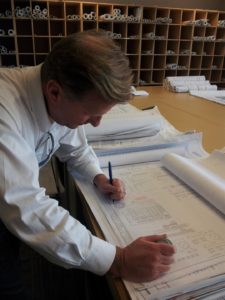Some architects might raise an eyebrow on the use of the words “code” and “innovation” in the same sentence—barring perhaps a diatribe on how the former impedes the latter. There is in fact a point of intersection between these seemingly disparate worlds, and I’d like to dip a toe into those waters to illustrate how fertile a ground this may be for architects.
Code Innovation from a Project Perspective

A relatively little used provision in all major codes allows for limitless flexibility, at least in theory. Architects can choose designs that push past code boundaries by using a process often called AMMRs: Alternative Materials and Methods Requests. The operative provisions are in a code chapter not often visited—Scope and Administration—in a subsection titled Duties and Powers of Building Official. The basic idea is simple: the code official can determine that a design that meets the “intent” of the code can be approved. Note “can” is quite different from “must.” Since this is a discretionary process, there are steps to follow, and no certainty of the outcome, but for those architects who take it on as part of their creative problem solving, the results can be profound.
I’ve personally used AMMRs to put windows where the code says “no”; to keep an historic four-story open stair; and to have a clear span wood truss be exposed as it punched through a rated corridor. I’ve seen AMMRs that add an additional story to a mixed-use building; allow wood framing where the code says “noncombustible”; and more. In each of these cases, the resultant building actually exceeds codes standards for protection of public health, safety, and welfare—because most code officials want to insure they are safely on the side of “better” rather than just “equal.”
The three questions that form the basic script for the AMMR process are pretty much the same everywhere:
What does a literal reading of the code require?
What is the intent of the current code requirement?
How can that intent be achieved by using alternative methods and means?
You can read more about AMMRs in a paper I co-authored here: https://www.woodworks.org/resources/getting-to-yes-making-effective-use-of-the-alternate-means-process/
For those who think such use of innovation in application of the code is imprudent, it’s helpful to reflect that many building features in common use today were once banned by prescriptive provisions in the building code. Examples include atrium buildings,, mass timber for high rise framing, plastic piping, and exits that don’t require a passageway leading out of a building (AKA horizontal exits).
Code Innovation from a Process Perspective

Looking past the individual project, the code processes, such as plan check and permit issuance, are also places where architects can inspire innovation. Permit process improvements typically require one to look past their current project conundrums toward shaping a path for smoother sailing that will benefit everyone in the future.
By way of example, in my own community, when a front page newspaper headline quoted the region’s largest developer as saying, “I will no longer do business here,” it got serious attention. After all, virtually ALL buildings come from actions by the private sector—whether building new or investing in retrofit and repurposing of existing buildings. When development stops, communities suffer. If code processes stymie investment, streamlining becomes civic life support. Architects are well equipped to step into these kinds of situations to help forge new paths forward. The result in my community after an intense, multiyear effort that culminated in a “Development Oversight Commission”? A move in regional development services surveys, from worst, to first.
In a community in crisis—where relationships and trust have deteriorated to the point that the building department is planning bullet proof glass at the counter (really!)—the long path to change culture, habit, and attitudes becomes a widely championed civic mission. But it does not take crisis to improve permit process efficiency and effectiveness.
For example, I found that working collaboratively over a one year period with a wide range of stakeholders—including different jurisdictions that had previously done little in concert—could lead to a permit streamlining program able to cut processing time by up to 70%. This is PASS, in use today in 19 northern California jurisdictions. This program does not change roles and responsibilities on either side of the counter; it just rewards well-structured plans and reviews. You can find more on PASS here: http://streamlineinstitute.com; and a broader set of permit streamlining resources here: https://permitstreamline.com/.
The Streamline Institute, which is the non-profit custodian of PASS, has studied permit process streamlining at jurisdictions around the country and identified foundational principles which have been distilled into a free AIA toolkit designed to support process innovation anywhere. Download it here: https://www.aia.org/resources/6398482-permit-streamlining.
This AIA resource explains what is readily possible; describes the core strategies that can be used individually or in combination; and outlines case studies gathered from around the county that show architect as leaders in shaping their own community’s permit processes. It also does some “myth busting,” challenging dusty old thinking that can hold back moves toward success on these kinds of adventures.
Innovation in Building Code Provisions
By design, code change tends to be slow and meticulous. Most architects mirror the building industry as a whole, preferring a measured pace for code changes. In practice, building design involves ideation based on code memory, supplemented with an intuitive understanding of code principles. Rapid change can sometimes throw a monkey wrench into the mix. When we do see very sudden code shifts, it’s often by legislative action in response to tragedy. An example: the new attention to balconies in the uniform codes. These sudden shifts may or may not include architects in their development.
The traditional multi-year code cycle is something of an intricate dance that involves many hundreds of volunteers who actually write the code, which is then curated by the seasoned hands at the International Code Council (ICC) who publish it. The process tends to include mostly code specialists, with relatively few practicing architects engaged. As this national code framework trickles down to become operative code almost everywhere, there are countless opportunities to engage, but only handfuls of architects are among the many proposing, testifying, and voting on code changes.
There are, however, along this long and winding path, gaps and disconnects that develop that can have direct impact on the work, interests, and actions of all architects. These gaps are key opportunities for architects and the AIA to engage. There is no doubt that focused efforts by a small number of passionate professionals can have major impacts even at the local adoption stage.
Two current examples from my work over the last few years as a consultant to AIA California:
- Updating the California Existing Building Code to encourage the retrofit and reuse of more of our obsolete and underutilized commercial building stock
AIA CA has been working very hard in leading a major California code update that would bring to our profession six “missing IEBC chapters.” This would activate a code compliance path called the “Work Area Method” in California for the first time. In addition, the ICC IEBC Performance chapter will be included in California code books to serve as a resource when needed for project based innovation—such as the AMMRs already discussed. This performance chapter is the only place in the ICode framework that compares life safety issues on a numerical scoring basis, and it can be valuable when exploring creative code compliance options.
Expanding the CEBC will have no downside for architects, as the choice of compliance method is up to the design professional. Those most comfortable with California’s existing limited prescriptive approach can continue with that. Those interested in the more nuanced and flexible Work Area method will find it now available. AIA CA will also be curating training to assist those innovators. The real world benefits of these major changes to California’s existing building code will be in support of reuse and retrofit of more of our existing building stock, with particular focus on the opportunities created by new state planning laws that support conversion of obsolete commercial structures to new and innovative forms of housing. These reuse and retrofit projects yield major embodied-carbon climate benefits immediately, while at the same time boosting urban economic vitality.
- Updating the California Building code to more proactively support decarbonization and climate action
Over a decade ago, AIA CA was a motive force in creating the original CalGreen, groundbreaking at the time as the world’s first green code. Recently, changes in our understanding of the importance and urgency associated with effective climate action in shaping the built environment have made it clear that CalGreen needed a refresh. Since knowledge of what is needed to protect our environment has developed quickly, much of it is either absent or underplayed. AIA CA has been working to bridge this gap, first by encouraging launch of a new CalGreen development process, manifested in the founding of the CCRC (CalGreen Carbon Reduction Collaborative) by key state agencies in 2022. AIA CA set to work immediately, using this platform to build a coalition of collaborative subject matter experts and stakeholders to shape for adoption the first embodied carbon considerations into California building code. Embodied carbon is very important for near term climate action, as Greenhouse Gas impacts (aka carbon) occur all at once when projects are constructed. Studies have documented that even high performing new buildings can take decades to recover these initial impacts via operational carbon savings.
The proposed new CalGreen mandatory measure addresses embodied carbon for large projects over 50,000 sq. ft. This size is a “sweet spot,” where benefits are significant, while touching a numerically small number of projects. These large projects also tend to have project teams that are already equipped with the skills to consider embodied carbon in design. The new provisions will provide both prescriptive and performance compliance options, maximizing design professional flexibility and choice. The options range from simple use of widely available material data, to performance based Whole Building Lifecycle Assessment. There is also a mechanism to encourage reuse and retrofit of existing buildings, as these projects by nature have low near-term carbon impacts.
Both these major code development initiatives are being proposed during the current “mid-cycle” code development calendar for an effective date of mid-2024. Both changes will help shift building industry culture and habit toward early consideration of greenhouse gas impacts to benefit all citizens. For more information on these code changes, see “Climate Action Via Code Change.”
All in all, architects have many avenues to use creative energy in a more efficient and effective code and regulatory environment. These are, after all, OUR codes!
Cover image of pre-digital era paper building department plan bins by the author.
From arcCA DIGEST, Season 13, “Innovation.”





